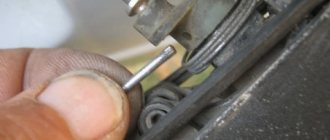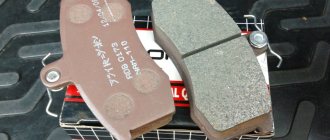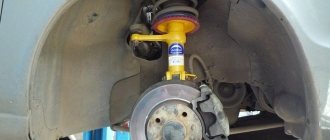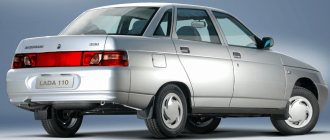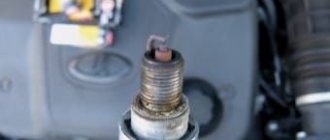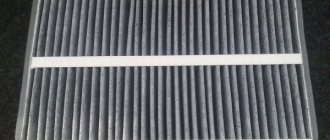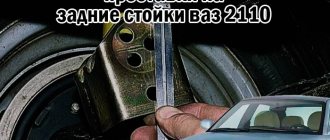July 19, 2020 Lada.Online 16,574 3
Rear suspension with coil springs, double-acting telescopic hydraulic shock absorbers and trailing arms elastically connected by a transverse beam and a stabilizer bar. The following are instructions on how to change the rear shock absorbers and springs on a Lada Granta, Kalina 2 and Priora yourself.
The replacement process is shown on a Lada Granta car. For other models everything is done similarly.
When should you resort to repairing your car's depreciation system?
If the car is just from the showroom, then it still has the technical potential given to it; when the factory settings are functioning, the control system works flawlessly. It is very pleasant and comfortable to be in the car. But the situation changes dramatically when the car crosses the “Rubicon” of active operation for six months or a year. It seems that everything is starting to “crumble”, something is already tapping. And often an acute problem arises when you urgently need to decide where and how to change the rear struts on a Lada Kalina, purchasing the necessary components on the car market.
Shock absorption system
Symptoms of a problem
Damage to shock absorbers, unlike many other components of the car, is relatively easy to determine. It is worth thinking about the malfunction of the rear struts of the Kalina in the following cases:
- oil smudges on the shock absorber housing;
- rocking of the car when overcoming bumps;
- knocking in the rear suspension;
- strong lean when turning.
In any case, when doubts arise about the maneuverability of the car, its handling, or any discomfort is felt while driving, you should first of all pay attention to the rear pillars of the Kalina.
What will make a car enthusiast think?
- The situation is if you often have to drive off-road, on poor asphalt surfaces, when the vehicle’s suspension is subject to the aggressive influence of potholes, holes, and sharp soil. Initially, the car still resists the “traps” of poor-quality road surfaces, and then many parts become unusable: they either rust, or become covered with cracks, or succumb to rupture.
- Buying a used car. The seller is not always conscientious, and it is not necessary that he previously monitored the technical condition of the vehicle, thought about how to change the rear struts on Kalina, or eliminate emerging problems. Used cars are a lottery, and you can lose if you don’t have a minimum of knowledge about repairs and maintenance of the domestic automobile industry.
- Frequent changes of drivers. This is the situation when several people alternately drive one family car, especially when there are also novice drivers who have recently received a license and do not know how to change the rear struts on a Kalina; the profile video for them is just beginning to open up new horizons in understanding the structure of the car.
- A machine that sits idle for a long time has a negative impact on its rubber parts. And before you start an active driving period again, it is worth checking all its control systems to see if they are acceptable for use and if their condition is safe.
- Unfavorable temperature conditions. Sudden changes in temperature and increased humidity levels will also force the driver to soon figure out how to change the rear struts on a Lada Kalina, having first checked them.
How to make sure the rack is working properly?
Sometimes it is impossible to visually determine the cause of extraneous noise when the car is moving. For example, the rear pillars of the Lada Kalina are clean, without any oil stains. Rocking also does not allow one to unambiguously diagnose a malfunction. However, the knocking noise in the rear suspension area does not disappear.
In this case, you will have to drive the car onto a vibration stand. It simulates road irregularities, and special sensors monitor how various suspension elements perform. The data is transmitted to a computer, which draws conclusions about the serviceability of the racks. This pleasure, of course, is not free, but it won’t hit your wallet very hard either. The cost of computer diagnostics depends on the region and is within a couple of thousand rubles. But for this money, the owner will receive data not only on the condition of the shock absorbers, but also all components of the front and rear suspension, which is especially important if there is a long trip ahead.
Signs indicating wear on the rear shock absorber struts
- Constant creaking, clearly visible even inside the car.
- Deterioration in vehicle maneuverability.
- A decrease in the level of comfort in the car interior, when bumps in the road are felt, the vehicle itself rides harshly.
- In the arched opening of the rear wheel, it is easy to distinguish water and oil stains, which means that the rear pillar can no longer cope with the loads.
Rear shock absorber strut
Installation
Figure 10-4 — Orientation of the rear suspension shock absorber: 1 — lower spring support cup; 2 — rear suspension shock absorber; 3 — rear suspension arms; 4 - wheel; A - top point of the support cup
Install the shock absorbers into the eyelets of the levers, insert the bolts and tighten the nuts without tightening (spanner 19, interchangeable head 19, wrench).
Attention!
Orient the shock absorber so that the highest point “A”, Figure 10-4, on the lower spring support cup faces the wheel.
Install the compression stroke buffer, the protective casing assembled with the casing cover, the shock absorber hinge bushing, the lower cushion, the spring and the upper gasket onto the shock absorber.
Insert the shock absorbers into the holes in the rear wheel arches and lower the car until the shock absorber rods appear in the mounting holes to the car body.
Install the shock absorber upper hinge cushion, cushion washer, spring washer onto the shock absorber rod and tighten the nut, securing the shock absorber rod. The tightening torque of the nut is 31…37 N.m (3.1…3.7 kgf.m) (wrench A.57070, wrench type KL-4071-3117 f. “KLANN”, ratchet wrench, torque wrench).
Install the plugs for the shock absorber rod mounting points.
Raise the rear seat backs.
Install the rear wheels.
Place the vehicle on a four-post lift, apply the parking brake, and turn off the ignition.
Push the rear suspension two to three times with your hands.
Finally tighten the nuts of the bolts securing the shock absorber to the rear suspension arms. The tightening torque of the nuts is 70…80 N.m (7.0…8.0 kgf.m) (ring wrench 19, replaceable head 19, torque wrench).
The process of replacing rear shock absorbers and springs is also shown in the video:
Have you ever had to change the rear shock absorbers on a Grant or Kalina yourself?
Methods for diagnosing the depreciation system
- Vibration stand with computer diagnostics
- Technical inspection of the vehicle in the service
- Self-test the shock absorption system by pressing on the rear of the body, holding it, releasing it and monitoring the behavior of the vehicle. Positive result - the machine should return to its original position without unnecessary swings.
Diagnostics of the depreciation system
Purpose and design features of racks
The front struts are designed to reduce the impact of the road surface on the car while driving. If the road is full of uneven surfaces, then the operation of the struts in this driving mode is especially important. The front struts, as well as the rear ones, of the Lada Kalina allow you to smooth out the vibrations that occur in the body under the influence of inertia when driving on an uneven road surface. Even if the road has a smooth surface, the shock absorbers are still endowed with the function of holding the car steadily on a given trajectory.
Over time, the front struts become unusable, and then the owner, while driving, notices the appearance of difficulties in driving the car. He also begins to feel the smallest irregularities in the road surface, during which the body tends to sway and move from the set course. Efficient shock absorbers are designed to prevent this development of events.
Before starting repair procedures, you need to familiarize yourself in detail with the design aspects of these elements of the Lada Kalina chassis.
- The front oil struts have a two-pipe mechanism, the functioning of which is possible due to the internal movement of liquid, that is, oil. This design of the shock absorber is quite simple, but in operation a tendency to overheating has been revealed, which provokes the supports to deform. Selecting and replacing these product options is also easy.
- The front gas-oil struts operate under the influence of gas pressure. They are very effective and allow the Lada Kalina car to gain reliable protection from shock and rocking influences.
- Single-pipe structures. In most models, manufacturers use such versions of products in the stern suspension. Shock absorbers can please you with good heat transfer and fairly high efficiency. Disadvantages include low reliability and high sensitivity to shock loads.
The choice of product option is significantly influenced by the operating features. Primary replacement of struts in Lada Kalina is recommended after 100,000 mileage. Subsequent replacements must be carried out after approximately 80 thousand km, but we must not forget about the influence of the operational factor.
What tools are needed to repair and replace the rear strut?
- Socket head for 19, 17 and 24
- Vorotok
- A set of wrenches for working with shock-absorbing system fasteners
- Open-end wrench 17
- Wrench for unscrewing the strut rod nut
- Grover and bushings, washers, “donuts”
- Wire brush and rags
- Jacks
- Two spring ties for one strut
- Use WD-40 lubricant to turn rusted bolts
Tools for repairing and replacing the rear strut
Removal
Place the vehicle on a two-post lift and turn off the ignition.
Remove the rear wheels.
Place stands under the rear suspension arms and lower the car until the springs begin to compress.
Tilt the rear seatbacks forward.
Figure 10-1 — Attaching the rear suspension shock absorber to the car body: 1 — plug; 2 — rear suspension shock absorber rod; 3 — shock absorber rod mounting nut
Figure 10-2 — Rear suspension shock absorber with spring: 1 — protective casing; 2 — compression progress buffer; 3 — casing cover; 4 — bushing of the shock absorber hinge; 5, 9 — shock absorber cushions; 6 — spring washer; 7 — nut for fastening the shock absorber rod; 8 — shock absorber washer; 10 — upper gasket; 11 — rear suspension spring; 12 - bolt; 13 — rear suspension shock absorber; 14 - nut
Remove plugs 1, Figure 10-1, covering the mounting points of the rear shock absorber rods (flat-head screwdriver).
Lock the rods 2 and unscrew the nuts 3 securing the shock absorbers to the body (wrench A.57070, wrench type KL-4071-3117 f. “KLANN”, ratchet wrench).
Remove spring washers 6, Figure 10-2, shock absorber washers 8 and shock absorber upper cushions 5.
Figure 10-3 — Attaching the rear suspension shock absorber to the rear suspension arms: 1 — rear suspension arm; 2 - nut; 3 — rear suspension shock absorber; 4 - bolt
Suspend the car until the springs are unloaded, unscrew nuts 2, Figure 10-3, bolts securing the shock absorbers to the rear suspension arms, remove bolts 4 and disconnect the shock absorbers 3 from the rear suspension arms 4 (wrench 19, replaceable head 19, ratchet wrench).
Remove the shock absorbers and springs.
Remove spring 11 from the shock absorber, Figure 10-2, with gasket 10, lower shock absorber cushion 9, shock absorber hinge bushing 4, casing cover 3, protective casing 1 and compression stroke buffer 2.
How to remove and install the rear shock absorber Lada Kalina
It is convenient to carry out the work in an inspection ditch.
But if necessary, you can remove and install the spring and shock absorber of the rear suspension by placing the car on a flat horizontal platform. To perform the work, you will need an assistant, as well as:
— inspection ditch or overpass;
— a device for disassembling suspension struts.
We prepare the car for the work and hang the rear of the car on stands.
If there is no inspection ditch or overpass, remove the rear wheel of the car from the side of the shock absorber being replaced.
Recline the rear seat back.
Use a screwdriver to pry it off and remove the plug.
Using a 17mm L-shaped wrench, unscrew the nut of the upper shock absorber mounting, holding the shock absorber rod from turning with a special wrench.
You can use a 6 mm wrench to hold the shock absorber rod from turning, and use a 17 mm spanner to unscrew its nut.
Using a magnet, remove the spring washer from the shock absorber rod
Remove the upper support washer
Remove the top cushion from the shock absorber rod
Using a 19mm wrench, unscrew the nut of the bolt securing the shock absorber to the beam, holding the bolt from turning with a wrench of the same size.
If there is difficulty, knock out the bolt with a soft metal drift.
Move the lower end of the shock absorber towards the rear of the car and remove the shock absorber along with the spring
The spring gasket usually sticks to the body, from where it must be removed and ensure that there are no deformations or tears.
Remove the spring gasket
Remove the spring from the shock absorber
Remove the spacer sleeve with the lower cushion from the rod.
Remove the cover with the compression stroke buffer.
We take out the compression stroke buffer from the case
For ease of assembly, we attach the gasket with tape or tape to the spring, which will facilitate installation, while the end of the spring coil should rest against the protrusion of the gasket.
We put the cover on the cup, while the corrugation of the cover should be put on the flange of the cup.
We insert the compression stroke buffer into the case so that its corrugated part is at the bottom.
The end of the lower coil of the spring should rest against the protrusion of the shock absorber support
To make installation easier, you can put a piece of hose on the end of the rod
The hose will allow you to guide the rod into the hole in the upper support on the body
We install the shock absorber so that the shallower recess (shown by the arrow) under the spring faces the wheel, while the end of the lower coil of the spring on the left side of the car will face the rear of the car, and on the right - to the front.
We secure the lower end of the shock absorber, but do not tighten the nut.
Lowering the car onto the wheel, or lifting this side of the beam with a jack, insert the end of the shock absorber rod into the hole in the body and secure it.
Tighten the lower shock absorber mounting bolt in the “car on wheels” position.
After lowering the car to the ground, rock it vigorously several times. Tighten with the appropriate torques: the nut of the lower fastening of the shock absorber to the beam – 68–84 Nm (6.8–8.4 kgf m), the nut of the upper fastening of the shock absorber – 51–63 Nm (5.1–6.3 kgf m).
After driving 100 km, tighten these threaded connections again to the required torque.
Source
What happens if you ignore a shock absorber malfunction?
The clearance of the Lada Kalina is adapted to bad Russian roads. Consequently, the car should ride softer, but has a greater chance of losing control. If the shock absorbers are not replaced in time, the driver will have to drive at a lower speed to save his life.
Faulty shock absorbers will rock the suspension on any hole. And when a wheel hits a hole at high speed, the body begins to sway violently, causing a short-term loss of traction between the wheels and the road surface.
Because of this, the axle skids or drifts, which can cause an accident. Also, untimely replacement damages other mechanisms - for example, suspension silent blocks or support bearings.
Features of Kalina 2013
VAZ released the modernized Kalina for sale in 2013, having previously widely covered the upcoming event in the media. The debut took place on a grand scale. The car has really become more interesting in every sense. Now completely new power units have appeared, eight- and sixteen-valve, with a volume of 1.6 liters, with a capacity of 98 to 106 hp. with front-wheel drive, five-speed manual or four-speed automatic transmission. The simplest engine accelerates Kalina to a speed of 167 km/h, the most powerful - up to 190 km/h.
Kalina is stable, but the chassis should be carefully monitored
The model now has unprecedented options: a good security system, an increased degree of comfort. But what about the car's dynamics? The 2013 Lada Kalina turned out to be much more powerful and durable than previous developments. The car has many undeniable advantages, good engineering and design solutions.
Racks are one of the issues that require special attention. At the beginning of using the car, the driver notices that knocking noises appear on steep climbs and turns. As a rule, motorists hope that after traveling a certain number of kilometers this will go away, because lapping and rolling are needed. But over time, the knocking not only does not go away, but also becomes even stronger. In addition, they are accompanied by other troubles related to the vehicle’s handling and stability.
There is excessive rigidity of movement; it seems that the suspension does not want to perform its functions and filter out road irregularities. If there is a speed bump along the way, Kalina howls, informing the driver about the unpleasant impact. If suddenly the car gets into an off-road zone, it even starts to skid. To understand this issue, it is necessary to study the features of different types of struts as the most important parts responsible for driving quality.

